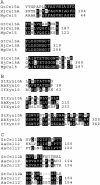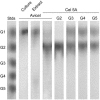Processive endoglucanase active in crystalline cellulose hydrolysis by the brown rot basidiomycete Gloeophyllum trabeum
- PMID: 15870328
- PMCID: PMC1087581
- DOI: 10.1128/AEM.71.5.2412-2417.2005
Processive endoglucanase active in crystalline cellulose hydrolysis by the brown rot basidiomycete Gloeophyllum trabeum
Abstract
Brown rot basidiomycetes have long been thought to lack the processive cellulases that release soluble sugars from crystalline cellulose. On the other hand, these fungi remove all of the cellulose, both crystalline and amorphous, from wood when they degrade it. To resolve this discrepancy, we grew Gloeophyllum trabeum on microcrystalline cellulose (Avicel) and purified the major glycosylhydrolases it produced. The most abundant extracellular enzymes in these cultures were a 42-kDa endoglucanase (Cel5A), a 39-kDa xylanase (Xyn10A), and a 28-kDa endoglucanase (Cel12A). Cel5A had significant Avicelase activity--4.5 nmol glucose equivalents released/min/mg protein. It is a processive endoglucanase, because it hydrolyzed Avicel to cellobiose as the major product while introducing only a small proportion of reducing sugars into the remaining, insoluble substrate. Therefore, since G. trabeum is already known to produce a beta-glucosidase, it is now clear that this brown rot fungus produces enzymes capable of yielding assimilable glucose from crystalline cellulose.
Figures




References
-
- Atalla, R. H., and D. L. Vanderhart. 1984. Native cellulose: a composite of two distinct crystalline forms. Science 223:283-285. - PubMed
-
- Beguin, P., and J. P. Aubert. 1994. The biological degradation of cellulose. FEMS Microbiol. Rev. 13:25-58. - PubMed
-
- Bradford, M. M. 1976. Rapid and sensitive method for quantitation of microgram quantities of protein utilizing principle of protein-dye binding. Anal. Biochem. 72:248-254. - PubMed
-
- Cohen, R., K. A. Jensen, Jr., C. J. Houtman, and K. E. Hammel. 2002. Significant levels of extracellular reactive oxygen species produced by brown rot basidiomycetes on cellulose. FEBS Lett. 531:483-488. - PubMed
-
- Davis, M. W., and R. T. Lamar. 1992. Evaluation of methods to extract ergosterol for quantitation of soil fungal biomass. Soil Biol. Biochem. 24:189-198.
Publication types
MeSH terms
Substances
Associated data
- Actions
- Actions
- Actions
LinkOut - more resources
Full Text Sources
Other Literature Sources
Molecular Biology Databases

